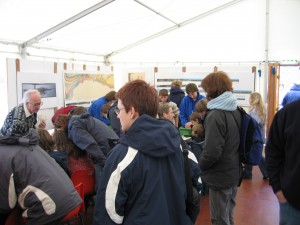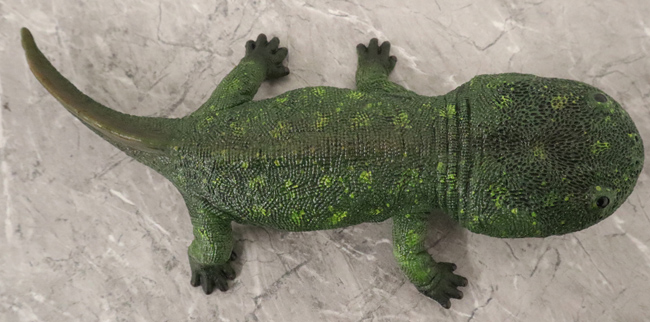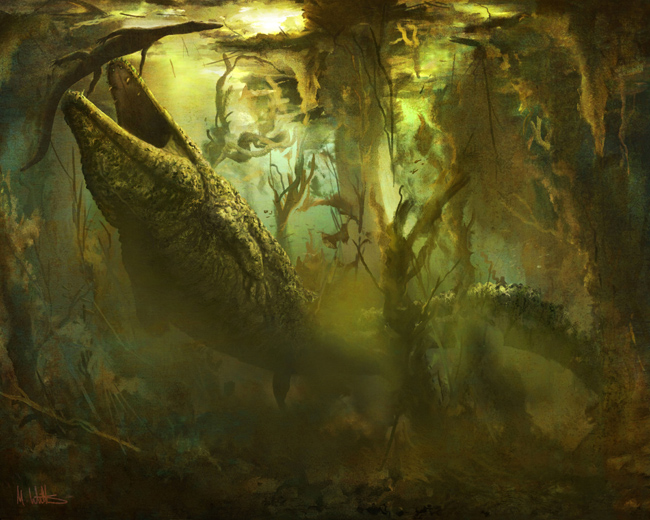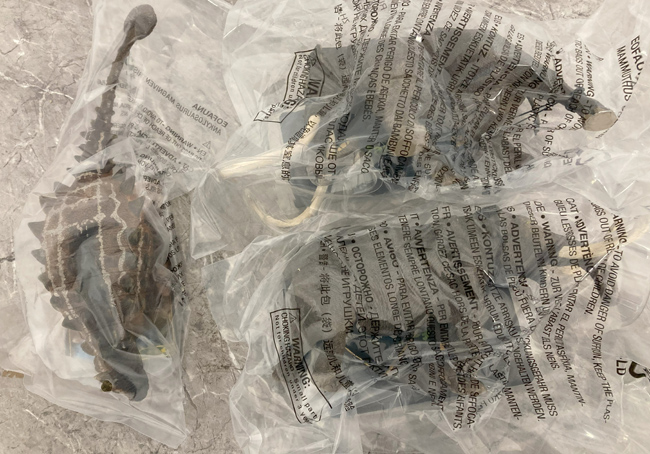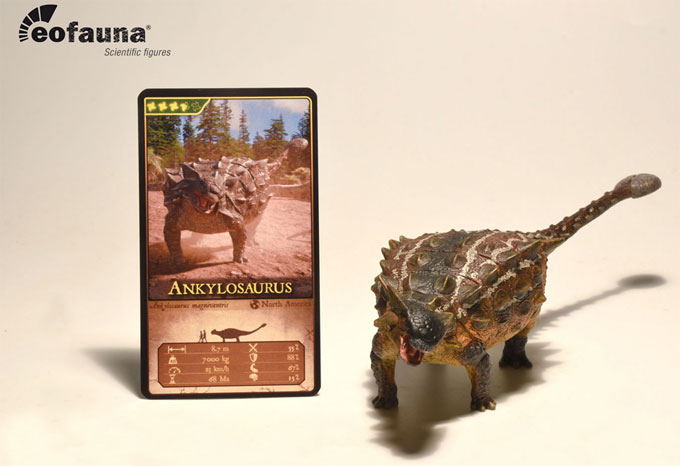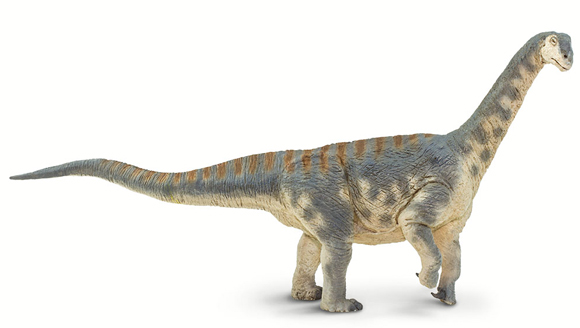A jumbled set of bones first spotted on a beach on the southern portion of the Isle of Skye in 1973 have been identified as a probable ornithopod. The Elgol dinosaur fossil is Scotland’s earliest recorded dinosaur fossil discovery. A research team led by Dr Elsa Panciroli (NERC Independent Research Fellow at National Museums Scotland), visited the site in 2018 and began the challenging process of extracting the fossil specimen from the surrounding boulders.
A specialist Canadian company was invited to supervise the extraction of the rare fossil. Once the difficult task of releasing the fossil slab was completed, it was carefully loaded onto an inflatable dingy and piloted safely back to port by a local crew from Elgol’s Bella Jane Boat Trips. The researchers were so worried about the fossil block sinking that they tied several buoys to it in the hope that if the boat should capsize, the rare fossil could still be located.

Lead author Dr Elsa Panciroli with the Elgol dinosaur fossil. The jumbled bones have proved difficult to identify. Picture credit: Neil Hanna.
Picture credit: Neil Hanna
The Dinosaur Fossil Record of Scotland
The fossil record of dinosaurs in Scotland mostly comprises isolated highly fragmentary bones from the Great Estuarine Group in the Inner Hebrides. These sediments were deposited in the Middle Jurassic (Bajocian–Bathonian faunal stage). The Elgol dinosaur fossil is estimated to be around 166 million years old. It is the first and most complete partial dinosaur skeleton currently known from Scotland. The material has been assigned a specimen number (NMS G.2023.19.1).
After manual preparation, the scientists were able to identify part of the spine, ribs and elements from the hips (a partial ilium). Unfortunately, micro-CT scanning failed to help with fossil identification. However, the team are confident that the material does represent a dinosaur, an ornithischian and most likely an ornithopod. If it does prove to be an ornithopod, then it would be one of the world’s oldest ornithopod body fossils described to date.

The Elgol dinosaur fossil has been interpreted to represent an early ornithopod. Picture credit: Maija Karala.
Picture credit: Maija Karala
Lead author of the study, Dr Elsa Panciroli stated:
“This was a really challenging extraction, in fact we’d previously felt was too difficult to collect the fossil, but I thought it was really important to study it. I was able to persuade the team to give it a try. It took a lot of hard work from a lot of people, but we did it: finally we can confirm and publish Scotland’s first recorded and most complete dinosaur, and that makes it all worthwhile”.
Cerapodan or Ornithopod Dinosaur
The ornithischian (bird-hipped) clade of the Dinosauria has been subdivided into several groups. Although the exact taxonomy remains undetermined, most palaeontologists distinguish two main groups. Firstly, there is the Thyreophora which comprises the armoured dinosaurs. In addition, there is the Cerapoda which can be further divided into the Ornithopoda and the Marginocephalia (ceratopsids and pachycephalosaurs).
The partial ilium and a histological analysis of fossil bone led the team to conclude that NMS G.2023.19.1 was definitely ornithischian and probably an early ornithopod. Ornithopods were much more common in the Early and Late Cretaceous. Famous ornithopods such as Iguanodon, Hypsilophodon and Mantellisaurus are associated with Lower Cretaceous deposits.
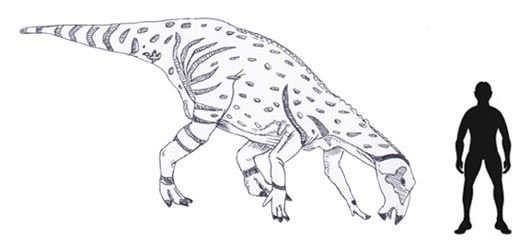
A Mantellisaurus scale drawing. An illustration of an Early Cretaceous ornithopod. Picture credit: Everything Dinosaur
Picture credit: Everything Dinosaur
The ornithopod illustration (above) is based on the CollectA Age of Dinosaurs Mantellisaurus model that was introduced in 2018. This was the same year when the fossil was removed from its difficult to access location.
To view the range of CollectA Age of Dinosaur figures, including many ornithopods: CollectA Age of Dinosaurs Figures.
Late Cretaceous ornithopods were extremely successful. Hadrosaurs became the dominant herbivores in many ecosystems. The Hadrosauridae family (duck-billed dinosaurs) had a global distribution. Some of these dinosaurs were enormous. For example, Shantungosaurus from the Late Cretaceous of China reached lengths in excess of fourteen metres.
The Elgol Dinosaur Fossil
The Elgol fossils suggest an animal about the size of a pony. Histological analysis concluded that the animal was at least eight years of age when it died. The new description of the Elgol dinosaur is published in the Earth and Environmental Science Transactions of the Royal Society of Edinburgh. If the fossil material does represent an ornithischian, as tentatively suggested from the partial ilium and histological sectioning, it represents the geologically youngest known occurrence in Scotland, and first from the Kilmaluag Formation. This adds to the diversity of dinosaurs known from the Middle Jurassic of the Isle of Skye.
To read an article about the types of dinosaurs that lived in this part of the world during the Middle Jurassic: Tracks of Middle Jurassic Dinosaurs.

A close-up view of the 166-million-year-old Elgol dinosaur fossil. Dr Elsa Panciroli carefully examines the fossil material. Picture credit: Neil Hanna.
Picture credit: Neil Hanna
Co-author of the study, Dr Stig Walsh (National Museums Scotland) said:
“This is a wonderful addition to the rapidly growing set of Jurassic finds from the Isle of Skye which are enabling us to learn more and more about the rich ecosystem of the time. We’ve known there were dinosaurs there for a while, most obviously from the famous footprints at An Corran, Brother’s Point and Duntulm and from individual bones, but it’s exciting to see a more complete, if still partial, skeleton. We’re delighted to add it to the other amazing finds now in the National Collection”.
Other recent Jurassic discoveries from Skye include the description of adult and juvenile mammals of the same species, Krusatodon, which revealed that these mammals grew more slowly than mammals today, and possibly one of the world’s largest Jurassic pterosaurs, Dearc sgiathanach.
To read Everything Dinosaur’s article about the Krusatodon fossils: Providing an Insight into Krusatodon Ontogeny.
To read about the discovery of D. sgiathanach: Fantastic Pterosaur from the Isle of Skye.
More Dinosaur Fossils?
Fellow author Professor Susie Maidment of the London Natural History Museum and the University of Birmingham, added:
“The Elgol dinosaur was a challenge to collect, and has proven perhaps an even bigger challenge to identify. Some aspects of the bones indicate that the specimen may be an ornithopod, a group of plant-eating dinosaurs that are best known from the Cretaceous. This specimen, however, would already have been a fossil by the time that the better-known ornithopods like Iguanodon and Hypsilophodon were walking the Earth. Recent research on the fossils of Elgol has revealed a diverse ecosystem of extraordinarily preserved Middle Jurassic animals, and I’m sure there are more exciting discoveries to come.”
The other authors on the paper were Professor Roger Benson (American Museum of Natural History), Professor Richard Butler (University of Birmingham), Brett Crawford (Research Casting International – RCI), Matt Fear (RCI), Dr Nick Fraser (National Museums Scotland) and Dr Gregory Funston (Royal Ontario Museum).
With the description of the Elgol dinosaur fossil, the significance of the Isle of Skye is once again emphasised. Furthermore, it demonstrates the importance of this part of Scotland in terms of learning more about the dinosaur biota from the Middle Jurassic.
Everything Dinosaur acknowledges the assistance of a media release downloaded from National Museums Scotland.
The scientific paper: “The first and most complete dinosaur skeleton from the Middle Jurassic of Scotland” by Elsa Panciroli, Gregory F. Funston, Susannah C. R. Maidment, Richard J. Butler, Roger B. J. Benson, Brett L. Crawford, Matt Fair, Nicholas C. Fraser and Stig Walsh published in the Earth and Environmental Science Transactions of The Royal Society of Edinburgh.
The award-winning Everything Dinosaur website: Prehistoric Animal Models.

